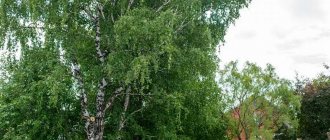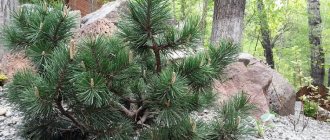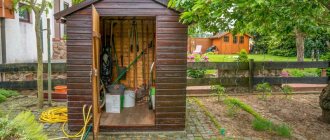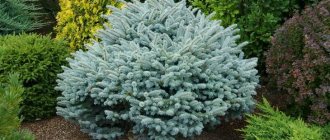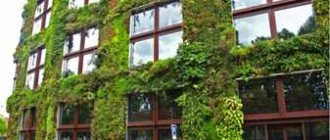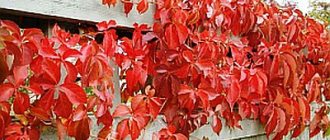Birch trees are widespread not only in Russia, but also in the northern hemisphere of our planet. Dwarf birch (lat. Betula nana), growing in the tundra mountains and peat bogs of the taiga, has many useful properties and is used in landscape architecture for landscaping.
Externally, the tree has little resemblance to an ordinary birch, so few people will guess what genus this plant belongs to.
Description of the species
The branched crown of the polar birch reaches 1.5 m in width. It is characterized by small, round leaves that fade from light green at the top of the plant to soft green at the bottom.
The leaves are attached to the stems by short petioles.
Descriptions of the different varieties of dwarf birch vary, but it is very difficult to find a tree more than 1 meter tall. These birches are so weak that sometimes they can only be seen close up - these are small caps of leaves slightly protruding above the ground.
Birch trees grow slowly and reproduce with small, round, slightly elongated thorns. When ripe, they are divided into their component parts - seeds and scales.
Nana begins to bloom before the leaves bloom. Modest flowers bloom very quickly, followed by small fruits that look like nuts up to 2 mm in size. The ground-climbing, beautifully curved and intertwined birch tree grows in northern Canada, Alaska and Russia.
The root system of the dwarf birch is designed so that the tree finds a place for itself among mountain rocks and swamps. This low shrub is widely used in landscape design due to its compact and rounded leaves that do not require special care.
Scientific information about the tree
A detailed description of the dwarf birch usually begins with the family to which it belongs. Biologists call it “Birch”, because the culture is truly a relative of everyone’s favorite tree. However, it has a completely different bark color, growth and shape of leaf blades.
The plant is also known by the following names:
- Ernik;
- slate;
- Karla.
In places where dwarf birches grow, dense plantings are formed.
They decorate mountain slopes at an altitude of up to 500 m. With them, it becomes “more fun” in the endless expanses of the tundra. Culture “dispels melancholy” in sphagnum bogs in the Siberian taiga. She has adapted wonderfully to the harsh climate :
- Chukotka;
- Kamchatka;
- Canada;
- Alaska;
- Altai;
- Scotland.
From the outside, the crop looks more like a shrub than a tree. The unique root system of the dwarf birch does not go deep into the soil. On the contrary, it rapidly spreads in different directions, avoiding stones and dense permafrost. The spreading crown is formed by a huge number of thin shoots that gracefully emerge from the main, slightly inclined trunk. They are not directed towards the sun, but in different directions. Thanks to this, a lot of snow remains on them, which protects the crop from the winter cold.
The maximum height of the dwarf birch reaches 150 cm, and the minimum barely reaches 20 cm. Young shoots are covered with miniature villi, reminiscent of velvet fabric. Over the years they disappear, leaving behind a brown-gray bark. The leaf plates have a rounded shape with a jagged frame. They are located alternately on the branches. The upper side of the sheet is glossy. The lower part is matte with thin pubescence. Each of them has a short petiole. In autumn the plates turn orange or bright red.
Like its close relative, the dwarf birch boasts yellow-green earrings in the shape of an elongated oval. In its natural environment, it blooms in May, when the foliage has not yet blossomed. After pollination, they begin to dry out, breaking up into miniature scales. After about a month, tiny brown nuts form.
Dwarf birch grows very slowly, so it is suitable for the design of open and spacious areas.
Varieties of dwarf birch
The tree is small in size, but not as simple as it seems at first glance. There are two groups of this type:
- Nana, distinguished by non-sticky shoots with fluff. The leaves are almost round, 2-2.5 cm in diameter. This variety is found in the northwestern regions of Asian countries, on mountain tops and in Greenland.
- In exilis, ungrown stems are sticky due to secretions. The leaves are small, no more than 1.2 cm in length and slightly wider. Dwarf birches of this group grow in the Asian part of Russia, Canada and Alaska.
Most varieties of decorative birch belong to the exilis subspecies. Dwarf golden birch grows very slowly, in 10 years it reaches no more than 30 cm in height and 70 cm in width. When mature, the tree reaches 70 cm in height and 1.5 m in width. It looks very impressive and therefore is a bright accent in landscape decor:
- The dwarf Golden Trege birch is a small and compact shrub with yellow, lacy leaves. It is highly valued by landscape designers for its decorative form and splendor. It looks like a highly branched, spreading shrub with slightly erect stems. A very rare variety, growing up to 10 cm per year. It blooms in May before the leaves bloom. Grows well in full sun or partial shade, the soil does not matter, but moderate moisture is desirable.
- Golden Dream is an ornamental deciduous shrub with a round, branched crown. It grows up to 1.2 m in height and 1.5 m in width. The apex of the leaf is slightly rounded, the base is broadly wedge-shaped, up to 2.5 cm in diameter. In summer the leaves are green, with a black border in the center, and towards the end they turn yellow. Flowering is the same as Trege, unpretentious to the soil, loves sun and moisture. Propagation is carried out by transplanting cuttings and seeds.
Characteristics of wood
In most cases, its height is 35-45 m, the radius of the trunk is 125-145 cm. All types of tree are considered:
- dioecious;
- monoecious;
- anemophilous.
READ What types of wood are there?
The roots of a tree most often go deep into the ground, but it happens that they lie on the surface. The central rod does not grow for a long time, but the lateral roots actively grow and have many fibrous roots.
In the first years, the young tree grows slowly, and then quickly grows into a large and beautiful tree.
Birch bark depends on the type of species. Primary colors:
- white;
- brown;
- yellow;
- black;
- grey;
- reddish.
The bark has a resin that gives it a white color.
Birch bark, as a rule, peels off from the trunk in ribbons. Old birch trees have bark that already has large cracks in the lower part. The leaves of the tree are 7 cm long and 4 cm wide. The shape is triangular-ovate. Birch trees bloom in early spring. In autumn the leaves turn yellow and fall off. Young breeds have a sticky layer on the leaves. Birch buds are transverse and arranged in a spiral pattern.
Spreading
Dwarf birch is widespread in the tundra, on mountain tops above 500 m above sea level, in peat bogs in the taiga zone. Outwardly, they do not look like the classic tall birch with a thin spotted trunk and large leaves.
Only a knowledgeable person can independently determine that this small, spreading shrub belongs to the birch species. In its habitat, the shrub forms dense thickets.
In the Niman dialect, dwarf birches are called dwarf birches (shrubs), and it is impossible to get through them - many curved branches are closely intertwined.
Dwarf birch grows in harsh conditions and is therefore fully adapted to them. In the Arctic zone it grows in the tundra, and in other regions - on mountain slopes and peaks.
Planting and care
Before planting dwarf ornamental birches, gardeners take into account several nuances:
- Trees are best planted in autumn.
- Dwarf plants are unpretentious to the soil, but it is better to mix garden soil with sand, humus and crushed stone. In addition, clay is used.
- The rhizome is placed in a small hole and carefully straightened.
- Everything should be well covered with soil on top.
- Then it should be watered without overdoing the amount of water.
You should also be careful:
- It is better to grow the plant in the light, in partial shade.
- During dry periods, it is better to periodically spray and water, especially after planting.
- Fertilize twice a year: with nitrogen fertilizers in the summer and complex fertilizers in the winter.
- Do not loosen the soil.
- It is useful to mulch the soil near the trunk of the bush to avoid overheating and evaporation of moisture.
- Since the shrub grows in harsh conditions, it is accustomed to frost.
- Shrub pruning should be done only in the second year after planting, in early spring.
- The dwarf shrub requires regular treatment against pests and fungi.
Growing conditions
- Lighting. Dwarf trees grow in the tundra primarily due to a lack of natural sunlight and frozen soil. A low-growing birch, of course, will not dry out in the shade; it will withstand difficult climatic conditions. But still, this plant is light-loving, it needs sunlight.
- The soil. Dwarf birch grows naturally in marshy soils. If you want to grow it in your home garden, you need to choose well-moistened, loose soil with weak acidity. Birch trees need to be watered frequently and abundantly.
- Temperature conditions. Yernik is unpretentious regarding temperature conditions. He will overwinter in the garden plot without any problems. But if the summer turns out to be very hot, you will need to protect the tree from the scorching sun. In an office or living room, you should not place a pot of dwarf birch near heating radiators.
- Humidity level. Ideally, plant a dwarf birch tree in an area where groundwater flows close to the surface of the earth. If this is not possible, then the soil is regularly and abundantly moistened. The birch tree will also need frequent spraying.
Reproduction
Propagation by seeds or cuttings. Collect the seeds after they have ripened in the ear buds and sow them immediately. It can also be sown in late autumn, covering everything with peat or sawdust.
This is a very labor-intensive process, and not every gardener will do it, so it is better to sow dwarf birch seedlings or cuttings. They can be purchased at nurseries in large quantities, so it is not recommended to buy them secondhand.
Also, you should not buy cuttings with an open root system, as they may simply not take root. It is best to purchase the plant in a container with soil or a lump of earth. Plant cuttings in late autumn or spring:
- The planting hole is prepared 14 days before planting by pouring garden soil, humus, peat and sand into the bottom in a ratio of 2:1:1:1:1.
- Then apply complex fertilizer, approximately 200 grams per hole.
- After planting, the area near the trunk is mulched with a large layer of humus, sawdust or other covering material.
- Watering is required.
Growing
First you need to ask yourself how to get a dwarf birch tree. You can bring them from a trip to the mountains, they are also sold in garden centers, and this plant is also grown from seeds. If dwarf birch seedlings have been received, we proceed to preparing the site for planting. There is no point in digging deep holes - the roots of this plant are small, but it is necessary to add peat, sand, humus and a little crushed stone to ordinary garden soil. A dwarf birch branch against a background of stone and lichens. Photo by the author The roots of the plant are placed in the hole, straightened to the sides, sprinkled with soil and watered abundantly. The dwarf birch loves moisture, and after planting it needs to be watered thoroughly, especially at first. In the future, this plant will not need special attention from the gardener. In dry summers it requires watering and spraying. It is advisable to feed it twice a season: in the spring with nitroammophos, and in the summer with any complex fertilizer. It is not recommended to loosen the soil under the bushes so as not to damage the roots. It will be very good to mulch the tree trunk with any material - sawdust, peat, pine needles, tree bark or even crushed stone - this will protect the plant from heat and rapid evaporation of moisture from the soil. There is no need to cover this plant for the winter.
Reproduction
In the conditions of the middle zone, dwarf birch seeds have time to ripen. For propagation, they are sown immediately after harvest or in late autumn under the snow. Unlike ordinary birch, dwarf birch propagates well by cuttings. The cut branches are placed in water, where they produce roots beautifully. Then the cuttings are planted in a school or immediately in a permanent place. You can choose dwarf birch in our market, which unites large online stores. Take a look at the selection of Dwarf Trees.
Meaning and Application
The tundra has favorable conditions for growing dwarf trees. That is why such shrubs are the most common plants of the tundra. There are entire impenetrable thickets of intertwined stems of bushes, especially in the southern part of the tundra.
Mosses, lichens and miniature willows, considered the only food of local residents, are considered neighbors in this region. The local population uses shoots of large bushes as fuel.
Thanks to their excellent decorative qualities, dwarf birch trees have found their use in garden design and landscape design. Garden birches will look good in the fall (autumn gardens); they are planted in rockeries, alpine gardens and group plantings. They look good in the company of low evergreen conifers and other similar species.
Use in landscape design
Dwarf birch is used for decorative purposes. It is suitable for small hedges, large areas of landscaping, exotic or Japanese motifs. The shrub also combines with small artificial ponds along with creeping willow. Garden birches are a good choice for gazebos and areas around the house. When planted in a pot, they become wonderful ornamental plants for the home, similar to bonsai.
Ornamental shrubs are an excellent addition to mixborders and rockeries, as well as gentians and sedums.
In the wild, the plant provides food for animals and fuel for humans, and the shrub is also considered medicinal. The dwarf ornamental birch is a wonderful addition to the landscape, being beautiful and attractive.
In combination with the same small cranberry bushes, ferns, and moss meadows, you get worthy examples of tundra wildlife.
Root protection
There are times when the foundation is light and the roots are approaching it, but there is no way to get rid of the tree. The most common option is a neighbor’s tree, planted in violation of the permissible distances, and your house/shed/bathhouse, also located not quite according to the rules. Then you will have to build a defense. You can “scare” the roots away from your site by changing the acidity of the soil. For example, some advise burying a thick layer of scrap asbestos sheets and building blocks along the house. Since it is smooth and strong enough, the roots will not be able to get caught and will most likely change the growth path. The decision is controversial. An alternative is a protective wall. If the problem is serious, you can pour the concrete barrier to the required depth.
